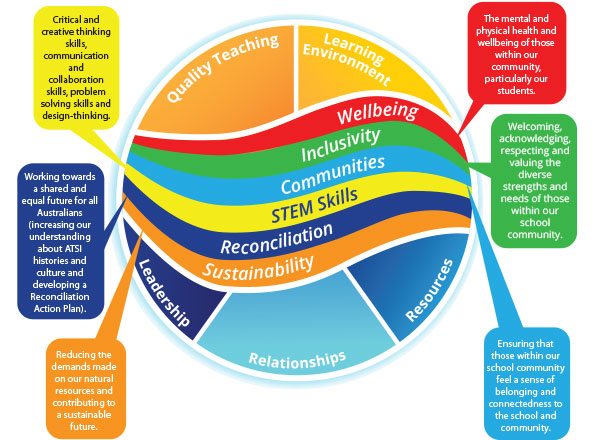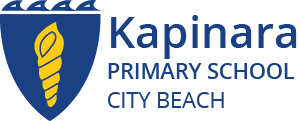View the Kapinara Primary School Business Plan 2023 – 2026

Find out more about the Focus Areas
HIGH QUALITY TEACHING
KEY FOCUS 1
Each classroom and context for learning is characterised by high quality teaching and learning
- Implement evidence-informed, whole school approaches to teaching, learning and assessment, prioritising those in Teaching for Impact.
- Adopt the shared language around teaching, learning and assessment within Teaching for Impact to maximise effective collaboration among staff at Kapinara PS, local network schools and other public schools.
- Classroom planning is directly aligned to the WA Curriculum, the strategic directions of the Department of Education WA and the KPS Business Plan 2024-2026.
- Staff collaborate to annually review practices against the National Quality Standard, sharing successes and identifying 2-3 priorities to focus on the following year.
KEY FOCUS 2
Whole school and classroom planning is informed by a range of high quality data, to identify and respond to the strengths and need so fall students
- Implement the school assessment and reporting policy, procedures and schedule to systematically collect and analyse a range of data (academic and non-academic), including feedback from students and families.
- Continue to develop the understanding and skills of staff in the analysis and interpretation of data.
- Students will be supported to interpret simple data that provides them with feedback on learning and helps them to set future goals.
- Staff have access to online platforms that enable them to monitor individual student progress across a range of areas.
KEY FOCUS 3
Opportunities for staff collaboration will be prioritised to promote consistent teaching and learning expectations, to monitor student progress, to share individual strengths and to learn from each other
- School level plans are developed, monitored, and evaluated by collaborative teams.
- Regular staff collaboration prioritises the discussion of student data (performance and wellbeing data, and student feedback) to support moderation, evaluate the impact of teaching strategies and inform the next phase of planning.
- Support staff to access opportunities to collaborate with colleagues from other schools, through our local schools’ network.
- Provide professional learning opportunities and establish protocols around peer observation focused on teaching practice.
LEARNING ENVIRONMENT
KEY FOCUS 1
The wellbeing of students and staff is prioritised and considered in all decision making
- A comprehensive wellbeing plan is developed with input from all stakeholders, and includes actively seeking advice, support and partnerships with individuals and organisations in the broader community.
- Establish a wellbeing team to develop a plan for staff wellbeing, aligned to the Department’s Staff Health and Wellbeing Strategy 2023–2027.
- Explore a range of measurement tools to enable information about staff wellbeing to be collected, analysed and discussed to inform planning.
- Continue to build on the existing support provided through the School Chaplaincy program by formalising roles, responsibilities and procedures and sharing this information with students and our community.
KEY FOCUS 2
The provision of a positive, safe, inclusive and caring learning environment in every context and for every child is a priority
- Develop, implement, monitor and annually review an explicit, coherent and sequenced whole school Health curriculum plan that incorporates evidence-informed approaches and resources.
- Finalise the development of Kapinara Primary School’s Student Behaviour Policy and Procedures, aligned to the Department of Education’s Student Behaviour Policy and Procedures, and the commitment to restorative approaches.
- Continue to prioritise professional learning that builds knowledge and understanding of restorative approaches and continues to build teachers’ skills in student engagement, including low-key responses that support positive behaviours and minimise unproductive behaviours.
- Develop class and year level protocols to embed student voice as a valuable source of information for monitoring student’s perceptions of physical, psychological and social safety at school.
KEY FOCUS 3
Student wellbeing is viewed as essential to student achievement and is a responsibility shared by the school, families, the school community and external agencies
- Personal and social capabilities such as self-awareness, managing emotions, building and maintaining relationships, communication, empathy and respect for self and others, are developed through explicit teaching and repeated opportunities to apply and practise them in authentic school contexts.
- A multi-tiered system of support is formalised and communicated to stakeholders to ensure students receive targeted support when required.
- Parents and carers are supported in increasing their understanding of factors that impact children’s wellbeing, and in identifying strategies and accessing resources suited to their individual family context.
- Explore with students, how they perceive ‘belonging’ and ‘connectedness’ at school, and co-design strategies to strengthen these critical aspects of wellbeing.
RELATIONSHIPS AND PARTNERSHIPS
KEY FOCUS 1
Strengthen relationships between the school and the community to develop a shared understanding of the purpose, direction and priorities of the school and ways in which we can work together to achieve them
- Develop and implement a comprehensive communication strategy to meet the needs and requests of the school community.
- Make explicit the way in which events, initiatives, strategies and resources are connected to specific elements of the school’s business plan.
- Share information with parents which enables them to better understand teaching, learning and assessment practices and ways in which they can best support their child’s learning and wellbeing.
- Explore ways in which the School Board can become authentically connected to and visible within the school community.
KEY FOCUS 2
Seek ways to ensure all students and families experience a sense of connection and belonging to the school community
- Continue to collaborate with students, the P & C and School Board to identify ways in which connection and a sense of belonging to the school community can be nurtured, and inclusive of all families.
- Continue to explore ways in which the school can draw on the expertise and experiences of members within the school and broader community.
- Explore further ways to celebrate and embrace the diverse backgrounds and strengths of students and families in the school community.
KEY FOCUS 3
Seek ways to establish partnerships with individuals, groups and organisations in the wider community to achieve and enhance outcomes for students
- Continue to invest in established partnerships with the Town of Cambridge and Cambridge Rotary.
- Where formal partnerships are forged, clearly define roles and responsibilities, and monitor to ensure partnerships are being implemented as intended.
- Identify indicators of success to enable the impact of the partnership to be evaluated.
LEADERSHIP
KEY FOCUS 1
Develop leaders who use their expertise to contribute to school improvement and the achievement of positive outcomes for students, staff and the school community
- Continue to develop internal leadership opportunities to systematically build a model of distributed leadership with clearly defined roles and responsibilities.
- Promote teacher participation in the Leading School Improvement programs offered through the Leadership Institute, particularly ‘Emerging and Team Leaders’ and ‘Leading Classroom Observation and Feedback’.
- Use the WA Future Leaders Framework to identify potential leaders and further develop the capacity of existing leaders (to undertake roles involving greater responsibility and complexity.
- Encourage and support staff to engage in opportunities for collaboration and leadership external to school, particularly those available through though our local network.
KEY FOCUS 2
Provide opportunities for students to develop leadership skills and to apply them in meaningful, authentic contexts within the school and community
- Collaboratively develop and document a shared understanding of what student leadership looks like at Kapinara PS, including processes for identification, nomination and selection; strategies for leadership development; resource allocation; and processes for monitoring and review.
- Enhance opportunities for student leadership which are visible within the school and the wider community.
- Collaboratively identify effective ways in which students can use their strengths and interests to authentically contribute to the goals and priorities of the school, including those articulated in our school motto ‘kindness, consideration and service for others’.
- Promote the use of student voice in decision making about the things that impact students’ learning, engagement and the extent to which they feel safe and supported at school.
- Explore ways in which younger students can develop emerging leadership skills and qualities.
RESOURCES
KEY FOCUS 1
Resources are allocated to maximise outcomes for students, and are aligned to the strategic directions of the Kapinara Primary School Business Plan 2024-2026
- Resource allocation prioritises professional learning for staff, and whole school, evidence-informed strategies aimed at improving outcomes for students.
- Teaching time is preserved and privileged, and collaborative time is used efficiently and effectively.
- The School Board and P & C explore potential funding opportunities via grants and sponsorship (Board only.
KEY FOCUS 2
Decisions about resource allocations are informed by ongoing analysis of need using a range of data
- Resources and resourced strategies are evaluated annually for evidence of their positive impact on student outcomes.
- Resources are committed over time (Reserve Accounts) to maintain and enhance the school’s physical environment, and ensure it is inclusive.
- The school partners with the P & C to systematically prioritise funding requests, targeting both short and long term projects.

